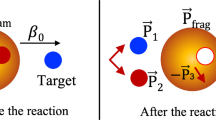Abstract
The Compressed Baryonic Matter (CBM) experiment is a fixed-target heavy-ion experiment planned at GSI's future international Facility for Antiproton and Ion Research (FAIR). CBM will study strongly interacting matter at high baryon densities where the QCD phase diagram is poorly known. The experiment applies a detector concept new to heavy-ion physics: All charged particles as well as secondary vertices from heavy-flavor decays are exclusively reconstructed in a high-performance silicon tracking system. It will be installed in a magnetic dipole field between the target and further detection systems for particle identification and calorimetry. High track densities and high collision rates require the application of most advanced silicon detectors. The technological challenges include high position resolution in thinnest possible pixel and microstrip sensors, combined with extreme radiation hardness, fast self-triggered readout and ultra low-mass mechanical supports. The article outlines the physics and detector concept of CBM and discusses the performance requirements of the silicon tracker and the beginning R&D.
Similar content being viewed by others
References
P. Senger et al.: J. Phys. G 30 (2004) S1087. C. Hohne et al.: Nucl. Phys. A 749 (2005) 141c. V. Friese et al.: in Quark Matter 2005, to be publ. in Nucl. Phys. A.
J. Eschke: J. Phys. G 31 (2005) S967. H.H. Gutbrod: Nucl. Phys. A 752 (2005) 457. W.F. Henning: AIP Conf. Proc. 773 (2005) 3. J. Stroth: Nucl. Phys. A 755 (2005) 209.
C. Lourenco: Nucl. Phys. A 698 (2002) 13. I. Arsene et al.: Nucl. Phys. A 757 (2005) 1. R.R. Becker et al.: Nucl. Phys. A 757 (2005) 28. J. Adams et al.: Nucl. Phys. A 757 (2005) 102. K. Adcox et al.: Nucl. Phys. A 757 (2005) 184.
P. Sonderegger et al.: J. Phys. G 30 (2004) S1027. K. Banicz et al.: Nucl. Instrum. Methods Phys. Res. A 539 (2005) 137. S. Damjanovic et al.: J. Phys. G 31 (2005) S903.
The UrQMD Collaboration: www.th.physik.uni-frankfurt.de/∼urqmd/.
S. Gorbunov, I. Kisel, and I. Vassiliev: www.gsi.de/documents/DOC-2005-Jun-181-1.pdf.
R. Turchetta et al.: Nucl. Instrum. Methods Phys. Res. A 458 (2001) 677. G. Deptuch et al.: Nucl. Instrum. Methods Phys. Res. A 535 (2004) 366.
G. Lutz: Nucl. Instrum. Methods Phys. Res. A 549 (2005) 103.
N. Wermes: Nucl. Instrum. Methods Phys. Res. A 512 (2003) 277.
Author information
Authors and Affiliations
Additional information
for the CBM collaboration
Presented in the Poster Session “Future Experiments and Facilities” at the 18th International Conference “Quark Matter 2005”, Budapest, Hungary, 4–9 August 2005.
Rights and permissions
About this article
Cite this article
Heuser, J.M., Muller, W.F., Senger, P. et al. A high-performance silicon tracker for the Compressed Baryonic Matter experiment at FAIR. Czech J Phys 55, 1649–1653 (2005). https://doi.org/10.1007/s10582-006-0054-1
Received:
Issue Date:
DOI: https://doi.org/10.1007/s10582-006-0054-1




